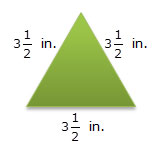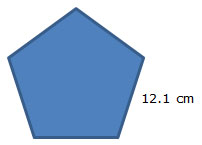
Which statement best describes the change in the perimeter of a triangle if all side lengths are multiplied by a factor of 3?
A. The new perimeter will be 3 times the length of the original perimeter.
Correct!
B. The new perimeter will be 6 times the length of the original perimeter.
Incorrect. Perimeter is a linear measure, so the perimeter will change by the same scale factor as the side lengths.
C. The new perimeter will be 9 times the length of the original perimeter.
Incorrect. Perimeter is a linear measure, so the perimeter will change by the same scale factor as the side lengths.
D. The new perimeter will be 27 times the length of the original perimeter.
Incorrect. Perimeter is a linear measure, so the perimeter will change by the same scale factor as the side lengths.
Which statement best describes the change in the circumference of a circle if the diameter is multiplied by a factor of 5?
A. The new circumference will be 25Π times the circumference of the original circle.
Incorrect. Circumference is a linear measure, so the circumference will change by the same scale factor as the diameter.
B. The new circumference will be 25 times the circumference of the original circle.
Incorrect. Circumference is a linear measure, so the circumference will change by the same scale factor as the diameter.
C. The new circumference will be 5Π times the circumference of the original circle.
Incorrect. Circumference is a linear measure, so the circumference will change by the same scale factor as the diameter.
D. The new circumference will be 5 times the circumference of the original circle.
Correct!
A triangle has the side lengths shown.

If the triangle is dilated by a scale factor of 2, what will be the perimeter of the new triangle?
A. 10 ½ inches
Incorrect. This number is the perimeter of the original triangle.
B. 21 inches
Correct!
C. 24 ½ inches
Incorrect. Because perimeter is a linear measure, the perimeter is changed by the same scale factor as the side lengths.
D. 42 inches
Incorrect. Because perimeter is a linear measure, the perimeter is changed by the same scale factor as the side lengths.
The regular pentagon shown has a side length of 12.1 cm. If the pentagon is dilated by a scale factor of 4, what will be the perimeter of the new pentagon?

A. 60.5 centimeters
Incorrect. This number is the perimeter of the original pentagon.
B. 121 centimeters
Incorrect. This number is the perimeter of the original pentagon multiplied by a scale factor of 2.
C. 242 centimeters
Correct!
D. 3,872 centimeters
Incorrect. Because perimeter is a linear measure, the perimeter is changed by the same scale factor as the side lengths.
Yancy’s grandmother makes quilts. A quilt that Yancy received for her birthday is made up of square blocks that each have a side length of 12 inches. If the finished quilt is made up of 4 rows of 4 blocks each, what is the perimeter of the finished quilt?
A. 48 inches
Incorrect. This number is the perimeter of the original quilt block.
B. 192 inches
Correct!
C. 3834 inches
Incorrect. Because perimeter is a linear measure, the perimeter is changed by the same scale factor as the side lengths.
D. 768 inches
Incorrect. Because perimeter is a linear measure, the perimeter is changed by the same scale factor as the side lengths.